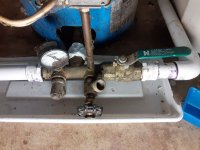wgadsby
New Member
My water system recently developed a pinhole leak in the pipe from the pressure tank tee to the pressure tank. The tank is an Amtrol WX-203 and is over 20 years old, so I've decided to replace it with an identical one, along with the associated fittings. I've attached a picture. The gray putty and pan are part of a temporary patch. The left side goes to the outdoor well pump and the right side goes to a water softener system. The left side has a PVC(F) to brass/copper (M) transition. The right side goes to a ball valve with a (F) threaded connection to PVC (M) transition. All piping is 1".
The replacement tank tee I have has threads on the outside and inside, so it could make a 1" or 3/4" threaded connection.
I've read that transitions from PVC to copper/brass should be male PVC to female copper/brass. With the PVC part on the outside, it can crack due to flexing over time. If I change the left PVC to copper fitting to a male PVC to the inside threads of the new brass tee, this means the PVC necks down to 3/4" briefly. I've also read that you should never neck down the pump to tank connection below 1" to minimize friction.
Would it be a problem using a 1" to 3/4" PVC to male threads adapter to connect the left side, due to friction? If so, what is the best way to do this? Thanks for any assistance.

The replacement tank tee I have has threads on the outside and inside, so it could make a 1" or 3/4" threaded connection.
I've read that transitions from PVC to copper/brass should be male PVC to female copper/brass. With the PVC part on the outside, it can crack due to flexing over time. If I change the left PVC to copper fitting to a male PVC to the inside threads of the new brass tee, this means the PVC necks down to 3/4" briefly. I've also read that you should never neck down the pump to tank connection below 1" to minimize friction.
Would it be a problem using a 1" to 3/4" PVC to male threads adapter to connect the left side, due to friction? If so, what is the best way to do this? Thanks for any assistance.

